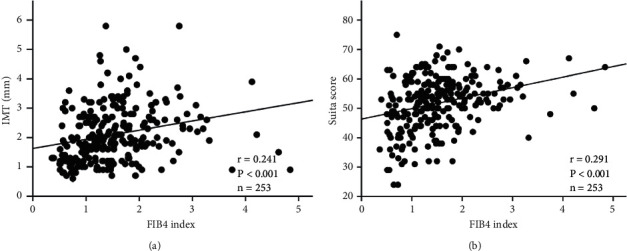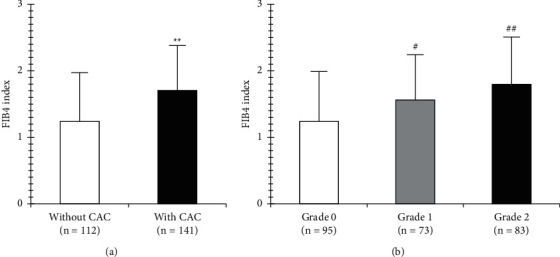纤维化-4指数与2型糖尿病患者动脉损伤及未来冠心病风险密切相关
IF 1.7
4区 医学
Q3 PERIPHERAL VASCULAR DISEASE
International Journal of Hypertension
Pub Date : 2022-07-07
eCollection Date: 2022-01-01
DOI:10.1155/2022/2760027
引用次数: 1
摘要
本研究评估了2型糖尿病患者纤维化-4 (FIB 4)指数与动脉损伤或未来冠心病(CHD)风险之间的关系。研究对象是253名2型糖尿病患者。计算所有受试者的FIB4指数,作为基于年龄、天冬氨酸转氨酶和丙氨酸转氨酶水平以及血小板计数的肝纤维化标志物。评估颈动脉内膜-中膜厚度(IMT)、颈动脉钙化(CAC)和主动脉弓钙化(AAC)等级(0-2)作为动脉粥样硬化变量。Suita评分计算为未来冠心病(CHD)的风险。我们评估了FIB4指数是否与动脉粥样硬化变量和Suita评分相关。FIB4指数与IMT (r = 0.241, P < 0.001)和Suita评分(r = 0.291, P < 0.001)显著相关。CAC患者的FIB4指数评分明显高于无CAC患者(分别为1.70±0.74和1.24±0.69,P < 0.001),而随着AAC的加重,fi4指数显著升高(分别为1.24±0.74、1.56±0.66和1.79±0.71,P < 0.001)。经临床特征校正后的线性回归分析显示,FIB4指数与IMT、Suita评分、CAC、AAC分级呈正相关(β = 0.241, P=0.004;β = 2.994, p < 0.001;β = 0.139, p =0.001;β = 0.265, P < 0.001)。FIB4指数与2型糖尿病动脉损伤和未来冠心病风险密切相关。本文章由计算机程序翻译,如有差异,请以英文原文为准。



Fibrosis-4 Index Is Closely Associated with Arterial Damage and Future Risk of Coronary Heart Disease in Type 2 Diabetes.
This study evaluated the association between fibrosis-4 (FIB 4) index and arterial damage or future risk of coronary heart disease (CHD) in type 2 diabetes. The study subjects were 253 patients with type 2 diabetes. The FIB4 index, as a marker of hepatic fibrosis based on age, aspartate aminotransferase and alanine aminotransferase levels, and platelet count, was calculated for all subjects. Carotid intima-media thickness (IMT), carotid artery calcification (CAC), and aortic arch calcification (AAC) grade (0–2) were assessed as atherosclerotic variables. The Suita score was calculated as the future risk of coronary heart disease (CHD). We assessed whether the FIB4 index was associated with both atherosclerotic variables and the Suita score. FIB4 index was significantly associated with IMT (r = 0.241, P < 0.001) and Suita score (r = 0.291, P < 0.001). Subjects with CAC showed a significantly higher FIB4 index score compared to subjects without (1.70 ± 0.74 and 1.24 ± 0.69, respectively, P < 0.001), whereas the FIB4 index was significantly elevated with a higher grade of AAC (1.24 ± 0.74, 1.56 ± 0.66, and 1.79 ± 0.71, respectively, P < 0.001). Linear regression analysis adjusted for clinical characteristics indicated that the FIB4 index was positively associated with IMT, Suita score, CAC, and AAC grade (β = 0.241, P=0.004; β = 2.994, P < 0.001; β = 0.139, P=0.001; and β = 0.265, P < 0.001, respectively). FIB4 index is closely associated with arterial damage and future risk of CHD in type 2 diabetes.
求助全文
通过发布文献求助,成功后即可免费获取论文全文。
去求助
来源期刊

International Journal of Hypertension
Medicine-Internal Medicine
CiteScore
4.00
自引率
5.30%
发文量
45
期刊介绍:
International Journal of Hypertension is a peer-reviewed, Open Access journal that provides a forum for clinicians and basic scientists interested in blood pressure regulation and pathophysiology, as well as treatment and prevention of hypertension. The journal publishes original research articles, review articles, and clinical studies on the etiology and risk factors of hypertension, with a special focus on vascular biology, epidemiology, pediatric hypertension, and hypertensive nephropathy.
 求助内容:
求助内容: 应助结果提醒方式:
应助结果提醒方式:


